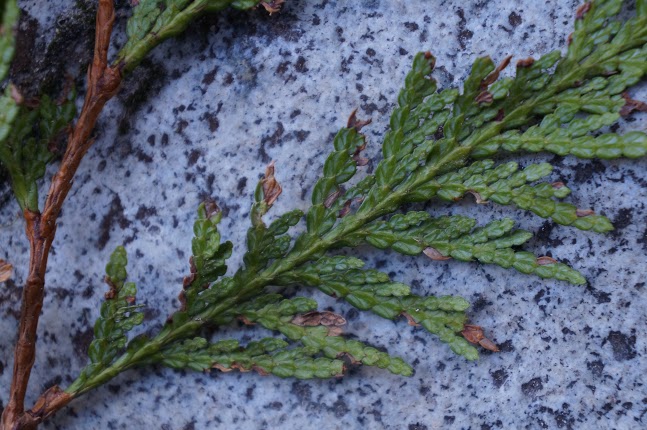Thuja Plicata commonly known as western or pacific red cedar is a member of the Cupressaceae family, a group of coniferous trees that also include redwoods and cypress trees (MacKinon et al. 1992). They are known for their distinct aroma and are a commonly used wood for outdoor construction and boat building. Cedar woods are particularly useful in moist environments due to the woods high natural resistance to decay (Chase et al. 2008). Due to this and its wide range across their lands red cedar has been called “ the cornerstone of northwest Native culture” and has had an array of uses across their cultures (Mackinnon et al. 1992). Western red cedar is B.C.’s provincial tree.
Classification:
Kingdom: Plantae
Division: Pinophyta
Class: Pinopsida
Order: Pinales
Family: Cupressaceae
Genus: Thuja
Species: T. plicata
Range:
Western red cedar grows along the pacific coast from Northern California to Southern Alaska and often grows alongside Douglas fir and western hemlock trees. It is found from elevations ranging from sea level to altitudes of around 2000m in some areas of Oregon (Milnore 1990). They tend to prefer moist and wet soils, usually in shaded forests. It grows best in seepage and alluvial sites but it also occurs in drier habitats (Mackinnon 1992)
Other Attributes:
The rot proof woods of the western red cedar have used at a large scale for thousands of years by pacific northwest Native American populations for the construction of important cultural items such as: dugout canoes, house planks, posts, totem and mortuary poles. It was the wood of choice for many other tools such as baskets, clothing, berry drying racks, fish weirs and spirit whistles and many more (MacKinnon 1992). Its distinctive bark is easily peeled off at certain times of the year was and still is often harvested by native populations. It is considered “the tree of life” by the Kwakwaka’wakw peoples of B.C. and the power of the red cedar is said to give strength to those who stand with their backs to the tree (Garibaldi et al 2004).
Conservation Status and Threats:
Despite this species being highly sought after for commercial logging due to its extensive range and abundance Thuja plicata remains ineligible for a threatened category on the IUCN redlist and is listed as Least Concern (Farjon 2013). It is unlisted on the COSEWIC database.
Written by Cameron McClure
Bibliography:
Chase, Jeri (2008). “Western Redcedar, “Tree of Life””. Forests for Oregon. Oregon Department of Forestry. pp. 18–19. Retrieved 18 September 2014
Farjon, A. 2013. Thuja plicata. The IUCN Red List of Threatened Species. Version 2014.3. <www.iucnredlist.org>. Downloaded on 17 November 2014.
Garibaldi, A. and N. Turner. 2004. Cultural keystone species: implications for ecological conservation and restoration. Ecology and Society 9(3): 1. [online] URL: http://www.ecologyandsociety.org/vol9/iss3/art1
MacKinnon, Andy; Jim Pojar and Ray Coupé (eds.). 1992. Plants of northern British Columbia. Vancouver, BC: Lone Pine.
Minore, D. 1990. Thuja plicata Donn ex D. Don, Western Redcedar, Cupressaceae -Cypress family. In Silvics of North America, volume 1: Conifers, Agriculture Handbook 654 tech . coord. R.M. Burns and B.H. Honkala 1210-1231. Washington D.C.: Forest Service, U.S. Department of Agriculture. http://www.na.fs.fed.us/pubs/silvics_manual/Volume_1/thuja/plicata.htm

